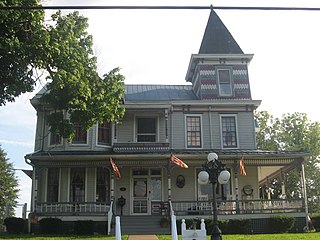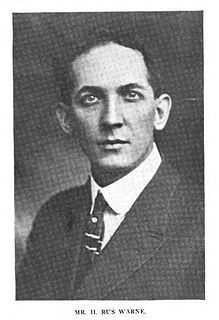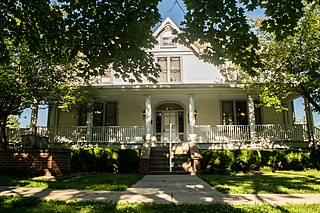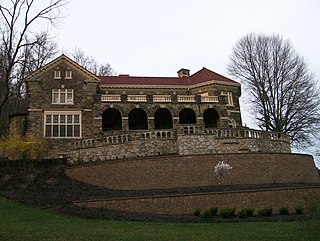Institute is an unincorporated community on the Kanawha River in Kanawha County, West Virginia, United States. Interstate 64 and West Virginia Route 25 pass by the community, which has grown to intermingle with nearby Dunbar. As of 2018, the community had a population of 1489, 54% of whom were African American.

The Henry K. List House, also known as the Wheeling-Moundsville Chapter of the American Red Cross, is a historic home located at 827 Main Street in Wheeling, Ohio County, West Virginia. It was built in 1858, and consists of a two-story square main block with an offset two-story rear wing. The brick mansion features a low-pitched hipped roof with a balustraded square cupola. It has Renaissance Revival and Italianate design details. The building was once occupied by the Ohio Valley Red Cross.

The William Miles Tiernan House, also known as the Tiernan-Riley House, is a historic home located at Wheeling, Ohio County, West Virginia. It was built in 1900–01, and is a 2+1⁄2-story, L-shaped, Georgian Revival-style brick dwelling. It features two-story Ionic order pilasters that flank the one-story entrance portico. The house was built for William M. Tiernan, who was vice-president of the Bloch Brothers Tobacco Company.

The Peter G. Van Winkle House was a historic home located in the Julia-Ann Square Historic District in Parkersburg, Wood County, West Virginia. It was built between about 1880 and 1899, and was a two-story duplex in the Queen Anne style. It featured a deck hipped roof with intersecting gables, turrets, and dormers. It was built on property once owned by former United States Senator Peter G. Van Winkle, who died in 1872.

Senator Stephen Benton Elkins House, also known as Halliehurst, is an historic mansion located at Elkins, Randolph County, West Virginia. It was designed by architect Charles T. Mott and built in 1890, as a summer home for U.S. Senator Stephen Benton Elkins. It consists of a three-story main block with hipped roof and service wing. The roof is punctuated by towers, turrets, dormers, and chimneys. A porch surrounds much of the first floor. It features a two-story portico with columns around a central, flat roofed tower. Located on a mountainside, it commands a view of the valley beneath and the forest and mountain peaks that surround the valley. In 1923, the house and approximately 60 acres of land were deeded to Davis & Elkins College by Sen. Elkins' widow.

Young-Noyes House, also known as the University of Charleston President's House, is a historic home located at Charleston, West Virginia. It was built in 1922 and is a white-painted 15-room brick house, featuring a central two-story gabled block and a shallow two-story gabled ell. It has a river-facing flat-roofed tetrastyle portico; the two-story smooth shaft columns are of the Doric order. The home is in the Colonial Revival style. It was purchased in 1951 to serve as the Morris Harvey College President's home.

Elizabeth Harden Gilmore House, also known as Minotti-Gilmore House or Harden and Harden Funeral Home, is a historic home and national historic district located at Charleston, West Virginia. It is a 2+1⁄2-story, Classical Revival brick detached residential dwelling built by 1900 on an approximately one-half acre lot in a business area of town. It features a columned portico and has undergone some alteration and deterioration. It was the home and location of a funeral home operated by Elizabeth Gilmore, a prominent African American in the Kanawha Valley.

Joseph S. Miller House is a historic home located at Kenova, Wayne County, West Virginia. It was built in 1891, in the Queen Anne style with Eastlake decorative elements. It is a two-story frame dwelling on a sandstone foundation with tower. It features a combination of wood fish scale, diamond and octagon shingles on the balcony, the west bay, and tower sections.

Harry Rus Warne was a Charleston, West Virginia-based architect.

East Hall is a historic home located on the campus of West Virginia State University at Institute, Kanawha County, West Virginia. It was built in 1893, and is a modest, two-story frame building with a hipped roof. In 1937, it was moved from the east side of campus to the west quadrangle. Until 1974, it was the official home to presidents of West Virginia State University and is the oldest building on campus.

Shaw House is a historic home and national historic district located at Fairmont, Marion County, West Virginia. The district includes two contributing buildings and two contributing structures. The main house was built in 1919, and is a 2+1⁄2-story dwelling in the Tudor Revival style. It features brick and stucco wall cladding punctuated with simulated half-timbering, and tall chimney stacks. Also on the property are a contributing garage, well house, and entrance pavilion. The house was built for Harry Shaw, a noted attorney and jurist of the early 20th century in north-central West Virginia.
Eastham House, also known as Glenn Manor, is a historic home located at Point Pleasant, Mason County, West Virginia. It was built about 1850, and is a two-story, "L"-shaped, brick residence with a low-pitched, slate covered gable roof in the Greek Revival-style. Also on the property is a contributing c. 1820 smokehouse.

Vance Farmhouse, also known as Meeks Farmhouse, Dean's House, and Bicentennial House, is a historic home located on a West Virginia University farm at Morgantown, Monongalia County, West Virginia. The original section was built about 1854, and is a two-story, I house form brick dwelling. The 1+1⁄2-story rear addition was built before 1900, and the two-story side addition on the northeast elevation was added in the 1930s. It features a wrap-around porch added sometime before 1900. The property was acquired for the West Virginia University Experiment Station in 1899. It housed the dean of the College of Agriculture from 1915 to 1957. During the United States Bicentennial in 1976, it was used as a showcase for exhibits on Monongalia County history. It has housed the West Virginia University Institute for the History of Technology and Industrial Archeology and is currently home to West Virginia University Press.

The L. S. Good House or Good Mansion is a historic home located in Wheeling, Ohio County, West Virginia. It was built in 1904 and was placed in the National Register singularly on November 28, 1988, and as part of the East Wheeling Historic District on November 22, 1999.

Lang-Hess House is a historic home located at Wheeling, Ohio County, West Virginia. It was built about 1865, and is a two-story sandstone building with Italianate design details. An attached ‘sun porch’ was added to the house about 1935. Its builder was associated with the architect and engineers of the Wheeling Suspension Bridge, and is believed to have used “extra” sandstone to build his residence following the work on bridge.

Johnson Camden McKinley House, also known as "Willow Glen," is a historic home located at Wheeling, Ohio County, West Virginia. It was built between 1914 and 1920, and is a 1+1⁄2-story massive dwelling built of ashlar sandstone. It consists of two wings that meet at right angles to form an "L" shaped building. The front elevation features a balustraded, one-story loggia that encloses a broad verandah above the piazza. The interior has a two-story entrance rotunda, a grand salon, an English-style library and 30 or so additional chambers. The house was built for coal baron Johnson Camden McKinley and his wife Agra Bennett McKinley.

John McLure House, also known as the Hans Phillips House, Lawrence Sands House, and Daniel Zane House, is a historic home located on Wheeling Island at Wheeling, Ohio County, West Virginia. It was built between 1853 and 1856 [when the island was a part of Virginia], and is a three-story, Federal-style brick dwelling. A two-story rear addition was built before 1870. A semi-circular columned portico and two-story, projecting side bay, were added in the late 19th century and added Classical Revival elements to the home.

"Edemar", also known as Stifel Fine Arts Center, is a historic house and national historic district located at Wheeling, Ohio County, West Virginia. The district includes two contributing buildings and two contributing structures. The main house was built between 1910 and 1914, and is a 2+1⁄2-story, brick-and-concrete Classical Revival mansion with a steel frame. The front facade features a full-width portico with pediment supported by six Corinthian order columns. Also on the property are a contributing brick, tiled-roofed three-bay carriage barn/garage; fish pond; and formal garden. The Stifel family occupied the home until 1976, when the family gave it to the Oglebay Institute to be used as the Stifel Fine Arts Center.
See-Ward House, also known as The Old Brick House, is a historic home located near Mill Creek, Randolph County, West Virginia. It is a two-story, brick I house with a gable roof in the Federal style. The house dates to 1801. Also on the property are a contributing shed, well, and barn site.

James Munroe Canty was an American educator, school administrator, and businessperson. Canty was an acting principal of the West Virginia Colored Institute in 1898 and is considered by West Virginia State as an acting president. Canty also served as the superintendent of Mechanical Industries for West Virginia Colored Institute from 1893 through 1914.




















